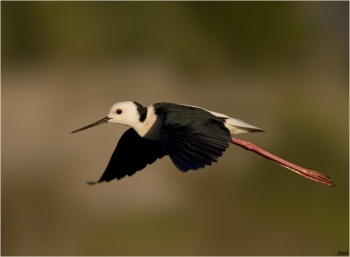Alternative name: Australian Stilt; Pied Stilt
- Himantopus leucocephalus
Identification
35–40 cm (13¾-15¾ in)
- Greenish-black back of the neck
- Black back, scapulars and wings also underwings
- Remainder of body white
- Smoky grey tail
- Red eyes
- Black bill (may be horn-coloured at the tip)
- Pink legs and feet
Distribution
Breeds from Indonesia to Australia and New Zealand; winters to Philippines.
Taxonomy
This is a monotypic species[1].
Nomenclature
A lot of the confusion over which name to use for this species comes from the disagreement over how many species of Stilts are found in the world. Opus inherited from Sibley and Monroe the view that six species exist, a view that is shared with Clements, while Howard and More only seems to recognize one species: Black-winged Stilt = Himantopus himantopus. The confusion does not get less from the fact that Black-winged Stilt = Himantopus himantopus is still in use, now meaning the stilt in Africa, Europe, and Asia. Often called Black-winged Stilt (which is the name for Himantopus himantopus) in Australia causing some confusion. Has also sometimes been called Australian Stilt or Pied Stilt (another name more often used for Himantopus himantopus).
Habitat
Lake margins, wet pasture, and riverbeds. Flocks at lakes and estuaries when not breeding.
Behaviour

Photo © by the late Rookery
West Shore Wildlife Reserve, Napier, New Zealand, 27 January 2017
Diet
They eat a wide variety of small aquatic vertebrates and invertebrates; also seeds are occasionally eaten.
References
- Clements, J. F., T. S. Schulenberg, M. J. Iliff, D. Roberson, T. A. Fredericks, B. L. Sullivan, and C. L. Wood. 2018. The eBird/Clements checklist of birds of the world: v2018. Downloaded from http://www.birds.cornell.edu/clementschecklist/download/
- Pierce, R.J., Kirwan, G.M. & Boesman, P. (2017). Black-winged Stilt (Himantopus himantopus). In: del Hoyo, J., Elliott, A., Sargatal, J., Christie, D.A. & de Juana, E. (eds.). Handbook of the Birds of the World Alive. Lynx Edicions, Barcelona. (retrieved from http://www.hbw.com/node/53759 on 21 March 2017).
- Adams, R. 2013. Pied stilt. In Miskelly, C.M. (ed.) New Zealand Birds Online. http://www.nzbirdsonline.org.nz
- Marchant, S.; Higgins, P.J. (eds) 1993. Handbook of Australian, New Zealand and Antarctic birds. Vol. 2, raptors to lapwings. Oxford University Press, Melbourne.
Recommended Citation
- BirdForum Opus contributors. (2024) Pied Stilt. In: BirdForum, the forum for wild birds and birding. Retrieved 25 June 2024 from https://www.birdforum.net/opus/Pied_Stilt
External Links





